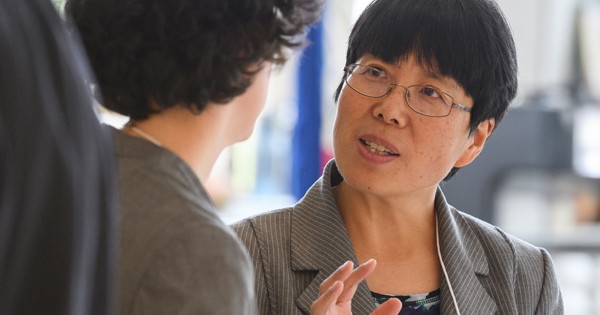Mechanical engineering Professor Liyun Wang is the sixth director of UD’s CBER
Liyun Wang, a professor of mechanical engineering, has been named director of the University of Delaware Center for Biomechanical Engineering Research (CBER), a research center that develops engineering science and clinical technology to reduce the impact of diseases like osteoarthritis, osteoporosis, degenerated discs, and cystic fibrosis on people.
“I am excited about the future prospects for the center under the leadership of Dr. Wang,” said prior CBER director and founding member Michael Santare, a professor of mechanical engineering. “Liyun has the energy and vision to keep CBER relevant and moving in the right direction.”
Researchers at CBER are studying how bone, cartilage, and ligaments respond to stress and strain; testing new compounds and biomaterials to prevent and treat osteoarthritis after traumatic injury; developing methods to help stroke and other motor-impaired patients walk again; and exploring the cellular mechanisms to promote tissue engineering.
Wang’s vision to expand on CBER’s principles
Since its founding in 1990, CBER has been interdisciplinary, bringing together faculty members in mechanical engineering, physical therapy, biological sciences, material sciences and engineering, kinesiology and applied physiology, and biomedical engineering who also collaborate with local hospitals and clinical facilities. These collaborations have led to many successful grants focused on research or student training. One example is the $30 million Center for Biomedical Research Excellence (COBRE) on Osteoarthritis Prevention and Treatment led by Thomas Buchanan (CBER director from 1998 to 2004) over the past 15 years.
Wang, who has been on the faculty at UD since 2005, hopes to continue a culture of interdisciplinary collaboration and facilitate the collective efforts of CBER faculty in pursuing large research proposals and training grants.
“We have a critical mass of faculty who are performing exciting biomechanics research across our campus,” she said. “CBER will serve as a hub for exchange of ideas and an incubator for cultivating the collaborative work.”
CBER also has a successful history of student research, including the NSF Research Experience for Undergraduates (REU) led by Jill Higginson (CBER Director from 2008 to 2014). For the past two summers, approximately twenty REU and CBER Summer Scholars participated in an intensive ten-week research, workshops, and social events.
“Training the next generation of scientists is what higher education is about,” said Wang. “CBER will continue to support the REUs for undergraduates. We will fund six more undergraduate summer scholars in CBER through the Vincent Baro fellowship provided by the Stanley Family Foundation. Meanwhile, we will explore mechanisms to support graduate student training.”
CBER also hosts a yearly research symposium and works with entrepreneurs to design and develop new technologies.
As director, Wang is adding a few new events to the agenda. She’s planning brown bag lunch sessions to encourage researchers to talk informally about their research—something she hopes will foster collaboration.
“The good ideas come from working together and inspiring each other,” she said.
Wang also plans to establish a visiting scholar program by inviting experts from other institutions to present their cutting-edge research and to interact with CBER faculty and graduate students.
“Hopefully these interactions would lead to collaborations and potential joint grant applications,” she said. “This program will also increase recognition of not only the center, but also the department and school.”
The growth of CBER
CBER has more than a quarter of century of history. Its predecessor, the Orthopedic and Biomechanical Engineering Center, was founded in 1990 with Ralph Cope as the founding director and Michael Keefe as co-director. Santare took the directorship in 1993.
Since its early years, the center has served as an experimental platform where new ideas are exchanged and interdisciplinary teams formulated. In 1998, Buchanan became the director and changed the center’s name and focus. In 2002, the center was awarded an NIH Biomedical Research Partnership grant and an NIH COBRE (Center of Biomedical Research Excellence) grant with Buchanan as principal investigator and faculty from mechanical engineering and physical therapy as investigators.
Buchanan led the successful renewal of the COBRE grant twice, in 2007 and 2012, and secured total funding of $30 million over the past 15 years. Kurt Manal served as the fourth director of CBER from 2004 to 2008, during which time many collaborative research projects were initiated, especially through the successful pilot research mechanism built into the COBRE grants.
In 2008, Higginson became the first female director. Building on the Center’s strong research capability and facility, Higginson initiated the CBER summer research program to promote undergraduate research. The initiative was very successful, and the Center was awarded two training grants by NIH and NSF in 2015 to support interdisciplinary senior design projects and summer REU scholars. Santare took the directorship again in 2014 and worked to increase collaborations with clinicians and industry. CBER now facilitates the translation of fundamental and applied research to patient care by supporting the design, characterization, validation and marketing of several surgical devices.


